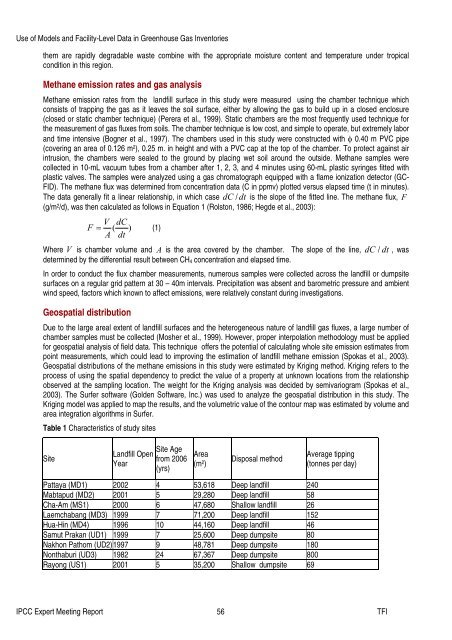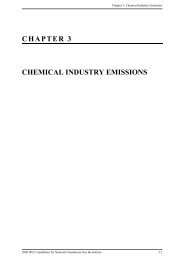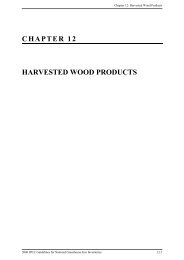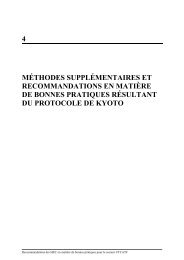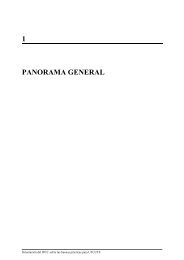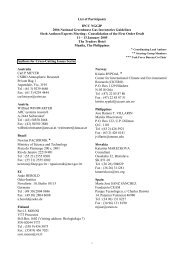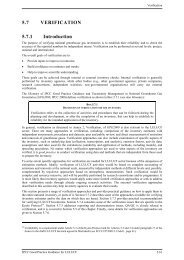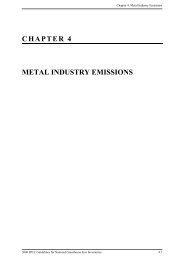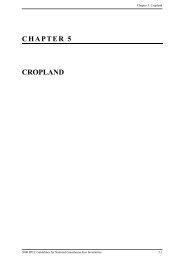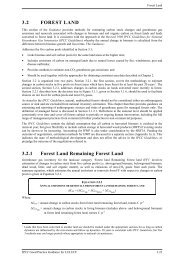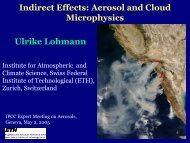Use of Models and Facility-Level Data in Greenhouse Gas Inventories
Use of Models and Facility-Level Data in Greenhouse Gas Inventories
Use of Models and Facility-Level Data in Greenhouse Gas Inventories
Create successful ePaper yourself
Turn your PDF publications into a flip-book with our unique Google optimized e-Paper software.
<strong>Use</strong> <strong>of</strong> <strong>Models</strong> <strong>and</strong> <strong>Facility</strong>-<strong>Level</strong> <strong>Data</strong> <strong>in</strong> <strong>Greenhouse</strong> <strong>Gas</strong> <strong>Inventories</strong><br />
them are rapidly degradable waste comb<strong>in</strong>e with the appropriate moisture content <strong>and</strong> temperature under tropical<br />
condition <strong>in</strong> this region.<br />
Methane emission rates <strong>and</strong> gas analysis<br />
Methane emission rates from the l<strong>and</strong>fill surface <strong>in</strong> this study were measured us<strong>in</strong>g the chamber technique which<br />
consists <strong>of</strong> trapp<strong>in</strong>g the gas as it leaves the soil surface, either by allow<strong>in</strong>g the gas to build up <strong>in</strong> a closed enclosure<br />
(closed or static chamber technique) (Perera et al., 1999). Static chambers are the most frequently used technique for<br />
the measurement <strong>of</strong> gas fluxes from soils. The chamber technique is low cost, <strong>and</strong> simple to operate, but extremely labor<br />
<strong>and</strong> time <strong>in</strong>tensive (Bogner et al., 1997). The chambers used <strong>in</strong> this study were constructed with φ 0.40 m PVC pipe<br />
(cover<strong>in</strong>g an area <strong>of</strong> 0.126 m 2 ), 0.25 m. <strong>in</strong> height <strong>and</strong> with a PVC cap at the top <strong>of</strong> the chamber. To protect aga<strong>in</strong>st air<br />
<strong>in</strong>trusion, the chambers were sealed to the ground by plac<strong>in</strong>g wet soil around the outside. Methane samples were<br />
collected <strong>in</strong> 10-mL vacuum tubes from a chamber after 1, 2, 3, <strong>and</strong> 4 m<strong>in</strong>utes us<strong>in</strong>g 60-mL plastic syr<strong>in</strong>ges fitted with<br />
plastic valves. The samples were analyzed us<strong>in</strong>g a gas chromatograph equipped with a flame ionization detector (GC-<br />
FID). The methane flux was determ<strong>in</strong>ed from concentration data (C <strong>in</strong> ppmv) plotted versus elapsed time (t <strong>in</strong> m<strong>in</strong>utes).<br />
The data generally fit a l<strong>in</strong>ear relationship, <strong>in</strong> which case dC / dt is the slope <strong>of</strong> the fitted l<strong>in</strong>e. The methane flux, F<br />
(g/m 2 /d), was then calculated as follows <strong>in</strong> Equation 1 (Rolston, 1986; Hegde et al., 2003):<br />
V dC<br />
F = ( ) (1)<br />
A dt<br />
Where V is chamber volume <strong>and</strong> A is the area covered by the chamber. The slope <strong>of</strong> the l<strong>in</strong>e, dC / dt , was<br />
determ<strong>in</strong>ed by the differential result between CH 4 concentration <strong>and</strong> elapsed time.<br />
In order to conduct the flux chamber measurements, numerous samples were collected across the l<strong>and</strong>fill or dumpsite<br />
surfaces on a regular grid pattern at 30 – 40m <strong>in</strong>tervals. Precipitation was absent <strong>and</strong> barometric pressure <strong>and</strong> ambient<br />
w<strong>in</strong>d speed, factors which known to affect emissions, were relatively constant dur<strong>in</strong>g <strong>in</strong>vestigations.<br />
Geospatial distribution<br />
Due to the large areal extent <strong>of</strong> l<strong>and</strong>fill surfaces <strong>and</strong> the heterogeneous nature <strong>of</strong> l<strong>and</strong>fill gas fluxes, a large number <strong>of</strong><br />
chamber samples must be collected (Mosher et al., 1999). However, proper <strong>in</strong>terpolation methodology must be applied<br />
for geospatial analysis <strong>of</strong> field data. This technique <strong>of</strong>fers the potential <strong>of</strong> calculat<strong>in</strong>g whole site emission estimates from<br />
po<strong>in</strong>t measurements, which could lead to improv<strong>in</strong>g the estimation <strong>of</strong> l<strong>and</strong>fill methane emission (Spokas et al., 2003).<br />
Geospatial distributions <strong>of</strong> the methane emissions <strong>in</strong> this study were estimated by Krig<strong>in</strong>g method. Krig<strong>in</strong>g refers to the<br />
process <strong>of</strong> us<strong>in</strong>g the spatial dependency to predict the value <strong>of</strong> a property at unknown locations from the relationship<br />
observed at the sampl<strong>in</strong>g location. The weight for the Krig<strong>in</strong>g analysis was decided by semivariogram (Spokas et al.,<br />
2003). The Surfer s<strong>of</strong>tware (Golden S<strong>of</strong>tware, Inc.) was used to analyze the geospatial distribution <strong>in</strong> this study. The<br />
Krig<strong>in</strong>g model was applied to map the results, <strong>and</strong> the volumetric value <strong>of</strong> the contour map was estimated by volume <strong>and</strong><br />
area <strong>in</strong>tegration algorithms <strong>in</strong> Surfer.<br />
Table 1 Characteristics <strong>of</strong> study sites<br />
Site<br />
L<strong>and</strong>fill Open<br />
Year<br />
Site Age<br />
from 2006<br />
(yrs)<br />
Area<br />
(m 2 )<br />
Disposal method<br />
Average tipp<strong>in</strong>g<br />
(tonnes per day)<br />
Pattaya (MD1) 2002 4 53,618 Deep l<strong>and</strong>fill 240<br />
Mabtapud (MD2) 2001 5 29,280 Deep l<strong>and</strong>fill 58<br />
Cha-Am (MS1) 2000 6 47,680 Shallow l<strong>and</strong>fill 26<br />
Laemchabang (MD3) 1999 7 71,200 Deep l<strong>and</strong>fill 152<br />
Hua-H<strong>in</strong> (MD4) 1996 10 44,160 Deep l<strong>and</strong>fill 46<br />
Samut Prakan (UD1) 1999 7 25,600 Deep dumpsite 80<br />
Nakhon Pathom (UD2) 1997 9 48,781 Deep dumpsite 180<br />
Nonthaburi (UD3) 1982 24 67,367 Deep dumpsite 800<br />
Rayong (US1) 2001 5 35,200 Shallow dumpsite 69<br />
IPCC Expert Meet<strong>in</strong>g Report 56 TFI


